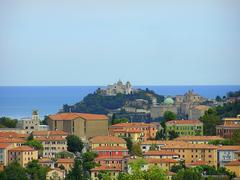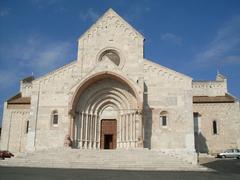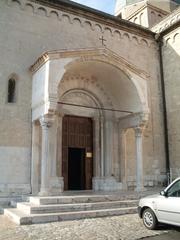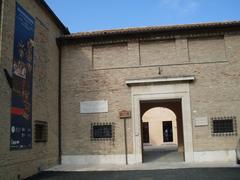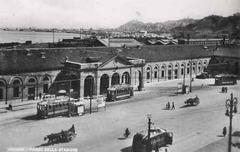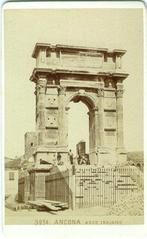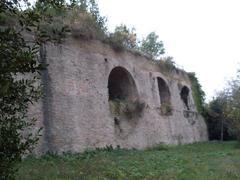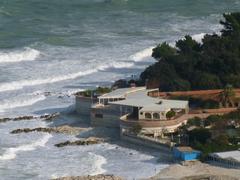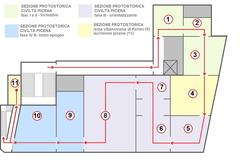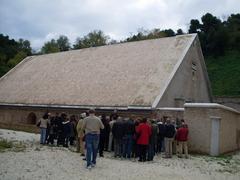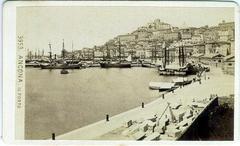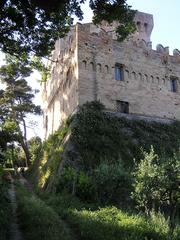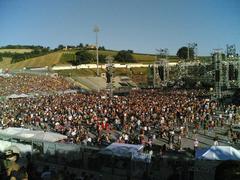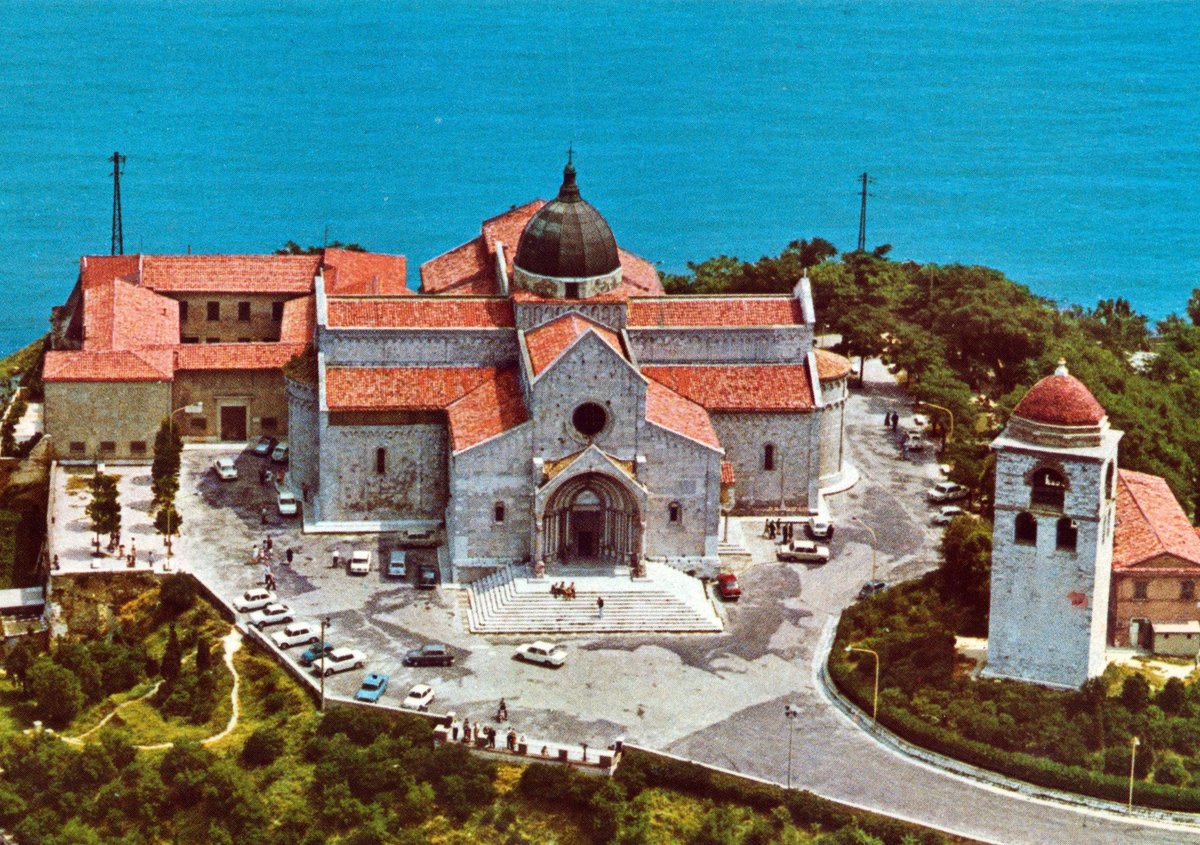
Cathedral Basilica of St. Cyriacus Ancona: Visiting Hours, Tickets, and Complete Visitor Guide
Date: 14/06/2025
Introduction
Perched atop Guasco Hill and overlooking the shimmering Adriatic Sea, the Cathedral Basilica of St. Cyriacus is one of Ancona’s most treasured landmarks. This iconic cathedral is not only the spiritual heart of the city but also a testament to nearly two millennia of evolving history, religious devotion, and architectural mastery. Built over the ruins of a 4th-century BC Greek temple and transformed through Byzantine, Romanesque, Gothic, Renaissance, and Baroque periods, the basilica stands today as a beacon for pilgrims, travelers, and lovers of art and history.
This guide provides an in-depth look at the cathedral’s layered history, architectural highlights, spiritual significance, and all the practical information you need for an enriching visit—including current visiting hours, ticket details, accessibility, and top nearby attractions. For further details and updates, refer to the Official Diocese of Ancona Website, Ancona Tourism Office, and Ecco Le Marche.
Table of Contents
- Introduction
- Historical Overview
- Religious Significance and Patron Saints
- Architectural Highlights
- Visiting Information
- Events, Pilgrimage, and Community Life
- Preservation and Restoration
- Photography and Visitor Conduct
- Frequently Asked Questions (FAQ)
- Visual Gallery
- Useful Links
- Conclusion
- References
1. Historical Overview
From Pagan Temple to Christian Basilica
The story of the Cathedral Basilica of St. Cyriacus begins in antiquity. Archaeological studies confirm that the site originally hosted a 4th-century BC Greek temple dedicated to Aphrodite, constructed by colonists from Syracuse. Parts of the ancient temple’s marble floors and foundations remain visible beneath glass panels in the nave, offering visitors a direct connection to Ancona’s earliest days (Comune di Ancona).
In the 5th–6th centuries AD, the temple site was repurposed for Christian worship. A basilica dedicated to St. Lawrence was constructed, signaling the city’s transition from paganism to Christianity. The crypt still preserves mosaic floors from this early phase (source).
Medieval Transformations
By the 11th and 12th centuries, the church was rebuilt in a Greek cross plan—a rare and distinctive form in Italy—under strong Byzantine influence. The central dome, constructed in the 13th century, remains one of Italy’s oldest and most architecturally significant. Romanesque and Gothic elements were added over subsequent centuries, including the monumental portal supported by marble lions and the addition of side chapels and a choir (Ecco Le Marche).
The adjacent episcopal palace holds its own historical weight, as Pope Pius II died here in 1464 while preparing a crusade following the fall of Constantinople (source).
Renaissance and Modern Era
Later centuries brought Baroque and Renaissance updates, particularly to the crypt and liturgical furnishing. The cathedral endured severe damage during World War II air raids and the 1972 earthquake. However, dedicated restoration efforts have preserved its ancient and medieval character (source).
In 1926, Pope Pius XI elevated the church to the status of “basilica minor.” Most recently, the cathedral took center stage during the 2011 National Eucharistic Congress attended by Pope Benedict XVI.
2. Religious Significance and Patron Saints
The cathedral is dedicated to Saint Cyriacus, the city’s patron and a deeply venerated bishop and martyr. His relics, along with those of Saint Marcellinus, were transferred to the basilica in 1017, establishing it as a major destination for pilgrims (Ancona Tourism). The crypt, where these revered relics are kept, is accessible to visitors seeking spiritual reflection.
The cathedral remains the seat of the Archdiocese of Ancona-Osimo and hosts major diocesan liturgies, ordinations, and religious events. Pope John Paul II lauded the cathedral in 1999 as “the image and centre of your Archdiocese” (Vatican.va).
3. Architectural Highlights
Setting and Exterior
Rising from the summit of Guasco Hill, the cathedral commands panoramic views over Ancona’s port and the Adriatic coast. The Romanesque-Byzantine façade features white Monte Conero stone and Greek marble, with a grand entrance flanked by iconic red marble lions—symbols of guardianship (Ecco Le Marche). Nearby stands a 14th-century bell tower and a modern statue of Pope John Paul II.
Interior and Crypt
The Greek cross layout draws visitors’ eyes toward the soaring 13th-century dome, a marvel of medieval engineering. The nave is austere yet harmonious, with sturdy columns and a wooden Venetian vaulted ceiling. The crypt, adorned in gold and Byzantine mosaics, houses the relics of St. Cyriacus. Archaeological remains—including early Christian mosaics and traces of the original pagan temple—are visible throughout the interior (Ecco Le Marche).
Materials and Symbolism
Built with luminous local limestone and Greek marble, the basilica’s walls and decorative features evoke both the city’s Hellenistic roots and its medieval Christian legacy. The Greek cross plan and dome symbolize the universality of faith, while the juxtaposition of pagan and Christian relics highlights the site’s continuity as a sacred space.
4. Visiting Information
Visiting Hours
- General Hours (2025):
- Monday to Saturday: 8:00 AM – 12:00 PM and 3:00 PM – 6:00 PM
- Sunday and Religious Holidays: 8:00 AM – 12:30 PM and 4:00 PM – 7:00 PM
- Typical visitor hours are 9:00 AM – 6:00 PM; check official sources for seasonal or event-related changes.
(Ancona Tourism)
Ticket and Tour Details
- Admission: Free for general entry.
- Guided Tours: Available in multiple languages, often for a small fee; booking in advance is advised.
- Museum and Crypt: Special access or tours may require tickets—check with the Diocesan Museum or tourism office for details.
Accessibility
- The cathedral is wheelchair accessible, with ramps at the main entrance.
- Some areas (crypt, bell tower) involve stairs and may be less accessible—contact in advance if you have mobility concerns.
Travel Tips and Nearby Attractions
- Getting There: The cathedral sits atop a steep hill; allow time for the climb or use a taxi for easier access.
- Nearby:
- Arch of Trajan
- Lazzaretto
- Museo Archeologico Nazionale delle Marche
- Parco del Cardeto
- Facilities: Restrooms are limited; cafés and restaurants are plentiful in the city center.
- Dress Code: Modest attire is expected, especially during services.
5. Events, Pilgrimage, and Community Life
The cathedral is a focal point for Ancona’s religious festivals, especially the feast of Saint Cyriacus (May 4th). It regularly hosts liturgical celebrations, concerts, and community gatherings. The panoramic piazza is a favored spot for reflection and photography.
6. Preservation and Restoration
Having withstood wars and earthquakes, the basilica has benefited from meticulous restoration, especially after World War II bombings and the 1972 earthquake. Ongoing preservation ensures that its architectural and artistic treasures remain accessible to future generations (source).
7. Photography and Visitor Conduct
Photography is permitted (no flash during services). Please maintain respectful silence, dress appropriately, and avoid disturbing worshippers, particularly during Mass or special ceremonies.
8. Frequently Asked Questions (FAQ)
Q: What are the visiting hours?
A: Typically 8:00 AM–12:00 PM and 3:00 PM–6:00 PM on weekdays; slightly extended hours on weekends. Always check official updates before your visit.
Q: Is there an admission fee?
A: No, general entry is free. Guided tours or special museum/crypt access may have a fee.
Q: Is the cathedral accessible?
A: The main floor is accessible by ramp. Some areas have stairs; contact the site for assistance.
Q: Are guided tours available?
A: Yes, in several languages; book ahead via the tourism office or cathedral.
Q: What are nearby attractions?
A: The Arch of Trajan, Lazzaretto, Parco del Cardeto, and Ancona’s archaeological museum.
9. Visual Gallery
- Exterior view of the Cathedral Basilica of St. Cyriacus with hilltop backdrop
- Interior dome showcasing Byzantine and Gothic elements
- Ancient mosaic floors in the crypt
(For more images and virtual tours, visit the official tourism sites.)
10. Useful Links
- Official Diocese of Ancona Website
- Tourism Office of Ancona
- Diocesan Museum Information
- Ecco Le Marche – San Ciriaco Cathedral
11. Conclusion
The Cathedral Basilica of St. Cyriacus is more than just a historical monument; it is a living testament to Ancona’s enduring spirit, bridging ancient and modern, pagan and Christian, East and West. With free public access, panoramic vistas, and proximity to Ancona’s other treasures, it is an unmissable destination for every visitor to the Marche region. Plan your journey, check current visiting hours, and immerse yourself in the rich heritage of this remarkable site.
12. References
- Cathedral Basilica of St. Cyriacus in Ancona: History, Visiting Hours, Tickets, and Travel Tips, 2025, Diocese of Ancona (source)
- Visiting the Cathedral Basilica of St. Cyriacus in Ancona: History, Hours, and Tips, 2025, Ancona Tourism & Wikipedia (source)
- San Ciriaco - Ancona’s Cathedral, 2020, Ecco Le Marche (source)
- Cattedrale di San Ciriaco Visiting Hours, Tickets, and Visitor Guide to Ancona Historical Sites, 2025, Ancona Tourism (source)
For more travel insights and up-to-date event news, download the Audiala app and follow us on social media.

